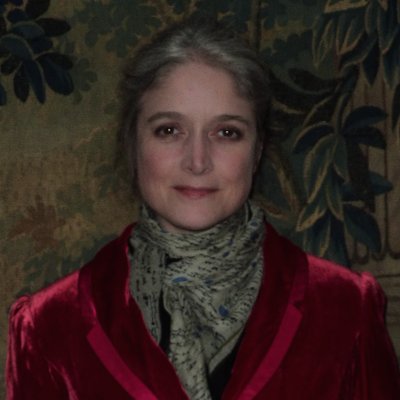Susan Owens is a freelance writer, curator and art historian – until a few years ago Curator of Paintings at the Victoria and Albert Museum in London. She says she’s now transitioning to becoming a ‘cultural’ historian, and this broadening of approach certainly showed in her deeply fascinating lecture. The Waterfront Hall was packed (yet again!) to hear her talk about how the ghost has been represented in British art and literature from medieval times until the present day. What a brilliant and unexpected subject!
Susan’s book The Ghost; a Cultural History was published by Tate in 2017, and she began her talk by explaining where the idea had come from. When she and her husband moved from London to an ancient house in a Suffolk village five years ago, she said, she was surprised that the most frequent question her friends asked about it was ‘is it haunted’? This set her thinking …
She began with a simple example of how popular ‘celebrity ghosts’ now are – especially with the National Trust!! – by putting up images of six separate houses said to be haunted by Ann Boleyn! But centuries ago, ghosts were a matter of life and death. In the Middle Ages life in Britain was short and it was dominated by the Catholic Church. Most people could not read, so pictorial images in churches were important. Faded frescos from parish churches show medieval ghosts represented as clothed skeletons, who were often taken to be messengers from individuals ‘trapped’ in Purgatory pleading for prayers to be said on their behalf to release them to heaven.
The Reformation banished the idea of Purgatory, but Susan Owens showed how the skeletal ghost was transformed during the 17th Century into a malevolent ‘spirit’, an agent of the Devil, against whom good Christians had to fight. Preachers used their pulpits to persuade their congregations that these spirits were invisible but everywhere. This was the ghost used as a tool of social control.
The rationalist Enlightenment undermined the political purchase of organised religion, but it created an intellectual and artistic space for the appearance of a more individualistic and emotional ghost in the late 18th Century Romantic movement. Susan Owens used images of classic paintings by the likes of Romney and William Blake to show how certain iconographic traditions developed to portray ghosts as representing extreme emotional states of grief or fear. Ghosts came to be enveloped in clouds, and to wear white sheets – an obvious reference to burial shrouds.
Then in the mid-nineteenth century the camera appeared on the scene and both revolutionised and popularised the ghost. ‘The camera never lies’, it is said; but it certainly did when it came to ghosts. It took a long time for an image to be properly captured in early photography, so if a person stood in a shot for a brief moment and then moved out of frame what was left was a faint see-through of an individual. Proof that ghosts existed! And a recognition for the first time that they were see-through! So a new culture of the ghost emerged that led to the establishment of a tradition of classis ghost stories by the likes of M.R. James, and of course the ghost has been a staple of the film industry for at least a century.
But why does our fascination with ghosts remain? Why do we so often ask the question of others ‘do you believe in ghosts?’ Susan Owens ended her talk by suggesting answer to this – we all use the word ‘haunted’ to describe our own deepest fears or most fearful memories, so maybe ghosts play a necessary role in allowing us to confront our own private demons.
In an email to the Lit &Sci society Susan Owens said that it had been an’ honour’ to speak to such a ‘fantastic audience’ as that in Hebden Bridge.
